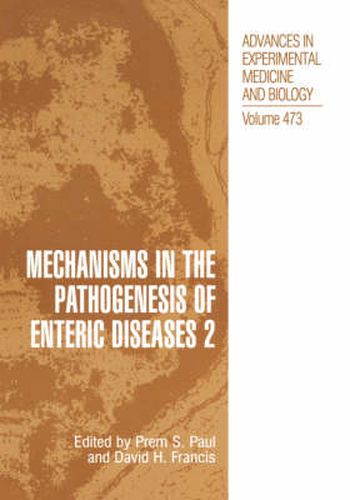Readings Newsletter
Become a Readings Member to make your shopping experience even easier.
Sign in or sign up for free!
You’re not far away from qualifying for FREE standard shipping within Australia
You’ve qualified for FREE standard shipping within Australia
The cart is loading…






This title is printed to order. This book may have been self-published. If so, we cannot guarantee the quality of the content. In the main most books will have gone through the editing process however some may not. We therefore suggest that you be aware of this before ordering this book. If in doubt check either the author or publisher’s details as we are unable to accept any returns unless they are faulty. Please contact us if you have any questions.
This volume covers the mechanisms of pathogenesis of enteric diseases. The topics include the epidemiology and pathobiology of enteric diseases, mechanisms of identity and interaction between host and pathogen, effector mechanisms in the pathogenesis and regulation of pathogenic activity in enteric diseases, and novel approaches to the prevention and therapy of enteric diseases. Diarrhoeal diseases caused by bacteria, viruses, and protozoa are among the most common diseases of animals and humans. They have also been among the most resistant diseases to prevent. Progress in the management of one disease is frequently overshadowed by the emergence of a new, more challenging enteric disease problem. The zoonotic character of many enteric pathogens links veterinary and medical concerns. At least five enteropathogens, Campylobacter jejuni, non-typhoid Salmonella, Escherichia coli O157:H7, Clostridium perfringens, and Cryptosporidium parvum, shed in the faeces of pigs, cattle, and/or poultry, are important causes of diarrhoea in human beings.
$9.00 standard shipping within Australia
FREE standard shipping within Australia for orders over $100.00
Express & International shipping calculated at checkout
This title is printed to order. This book may have been self-published. If so, we cannot guarantee the quality of the content. In the main most books will have gone through the editing process however some may not. We therefore suggest that you be aware of this before ordering this book. If in doubt check either the author or publisher’s details as we are unable to accept any returns unless they are faulty. Please contact us if you have any questions.
This volume covers the mechanisms of pathogenesis of enteric diseases. The topics include the epidemiology and pathobiology of enteric diseases, mechanisms of identity and interaction between host and pathogen, effector mechanisms in the pathogenesis and regulation of pathogenic activity in enteric diseases, and novel approaches to the prevention and therapy of enteric diseases. Diarrhoeal diseases caused by bacteria, viruses, and protozoa are among the most common diseases of animals and humans. They have also been among the most resistant diseases to prevent. Progress in the management of one disease is frequently overshadowed by the emergence of a new, more challenging enteric disease problem. The zoonotic character of many enteric pathogens links veterinary and medical concerns. At least five enteropathogens, Campylobacter jejuni, non-typhoid Salmonella, Escherichia coli O157:H7, Clostridium perfringens, and Cryptosporidium parvum, shed in the faeces of pigs, cattle, and/or poultry, are important causes of diarrhoea in human beings.